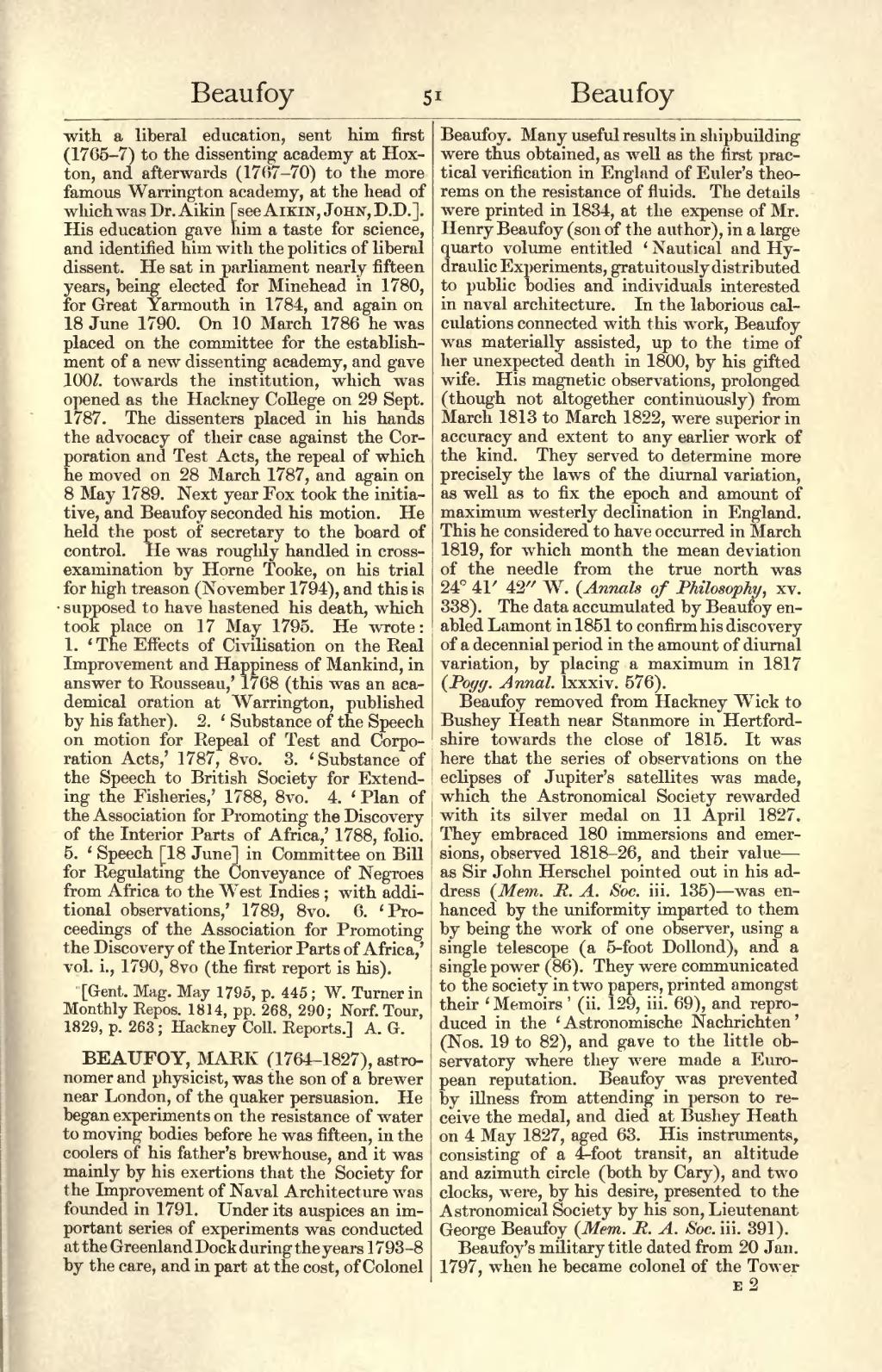with a liberal education, sent him first (1765-7) to the dissenting academy at Hoxton, and afterwards (1767-70) to the more famous Warrington academy, at the head of which was Dr. Aikin [see Aikin, John, D.D.]. His education gave him a taste for science, and identified him with the politics of liberal dissent. He sat in parliament nearly fifteen years, being elected for Minehead in 1780, for Great Yarmouth in 1784, and again on 18 June 1790. On 10 March 1786 he was placed on the committee for the establishment of a new dissenting academy, and gave 100l. towards the institution, which was opened as the Hackney College on 29 Sept. 1787. The dissenters placed in his hands the advocacy of their case against the Corporation and Test Acts, the repeal of which he moved on 28 March 1787, and again on 8 May 1789. Next year Fox took the initiative, and Beaufoy seconded his motion. He held the post of secretary to the board of control. He was roughly handled in cross-examination by Horne Tooke, on his trial for high treason (November 1794), and this is supposed to have hastened his death, which took place on 17 May 1795. He wrote: 1. 'The Effects of Civilisation on the Real Improvement and Happiness of Mankind, in answer to Rousseau,' 1768 (this was an academical oration at Warrington, published by his father). 2. 'Substance of the Speech on motion for Repeal of Test and Corporation Acts,' 1787, 8vo. 3. 'Substance of the Speech to British Society for Extending the Fisheries,' 1788, 8vo. 4. 'Plan of the Association for Promoting the Discovery of the Interior Parts of Africa,' 1788, folio. 5. 'Speech [18 June] in Committee on Bill for Regulating the Conveyance of Negroes from Africa to the West Indies; with additional observations,' 1789, 8vo. 6. 'Proceedings of the Association for Promoting the Discovery of the Interior Parts of Africa,' vol. i., 1790, 8vo (the first report is his).
[Gent. Mag. May 1795, p. 445; W. Turner in Monthly Repos. 1814, pp. 268, 290; Norf. Tour, 1829, p. 263; Hackney Coll. Reports.]
BEAUFOY, MARK (1764–1827), astronomer and physicist, was the son of a brewer
near London, of the quaker persuasion. He
began experiments on the resistance of water
to moving bodies before he was fifteen, in the
coolers of his father's brewhouse, and it was
mainly by his exertions that the Society for
the Improvement of Naval Architecture was
founded in 1791. Under its auspices an important series of experiments was conducted
at the Greenland Dock during the years 1793-8
by the care, and in part at the cost, of Colonel
Beaufoy. Many useful results in shipbuilding
were thus obtained, as well as the first practical verification in England of Euler's theorems on the resistance of fluids. The details
were printed in 1834, at the expense of Mr.
Henry Beaufoy (son of the author), in a large
quarto volume entitled 'Nautical and Hydraulic Experiments, gratuitously distributed
to public bodies and individuals interested
in naval architecture. In the laborious calculations connected with this work, Beaufoy
was materially assisted, up to the time of
her unexpected death in 1800, by his gifted
wife. His magnetic observations, prolonged
(though not altogether continuously) from
March 1813 to March 1822, were superior in
accuracy and extent to any earlier work of
the kind. They served to determine more
precisely the laws of the diurnal variation,
as well as to fix the epoch and amount of
maximum westerly declination in England.
This he considered to have occurred in March
1819, for which month the mean deviation
of the needle from the true north was
24° 41' 42" W. (Annals of Philosophy, xv.
338). The data accumulated by Beaufoy enabled Lamont in 1851 to confirm his discovery
of a decennial period in the amount of diurnal
variation, by placing a maximum in 1817
(Pogg. Annal. lxxxiv. 576).
Beaufoy removed from Hackney Wick to Bushey Heath near Stanmore in Hertfordshire towards the close of 1815. It was here that the series of observations on the eclipses of Jupiter's satellites was made, which the Astronomical Society rewarded with its silver medal on 11 April 1827. They embraced 180 immersions and emersions, observed 1818-26, and their value as Sir John Herschel pointed out in his address (Mem. R. A. Soc. iii. 135) was enhanced by the uniformity imparted to them by being the work of one observer, using a single telescope (a 5-foot Dollond), and a single power (86). They were communicated to the society in two papers, printed amongst their 'Memoirs (ii. 129, iii. 69), and reproduced in the 'Astronomische Nachrichten' (Nos. 19 to 82), and gave to the little observatory where they were made a European reputation. Beaufoy was prevented by illness from attending in person to receive the medal, and died at Bushey Heath on 4 May 1827, aged 63. His instruments, consisting of a 4-foot transit, an altitude and azimuth circle (both by Gary), and two clocks, were, by his desire, presented to the Astronomical Society by his son, Lieutenant George Beaufoy (Mem. R. A. Soc. iii. 391).
Beaufoy's military title dated from 20 Jan. 1797, when he became colonel of the Tower
